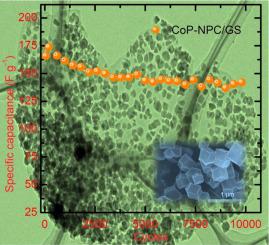Journal of Colloid and Interface Science ( IF 9.4 ) Pub Date : 2020-08-29 , DOI: 10.1016/j.jcis.2020.08.096 Sampath Gayathri 1 , Paulraj Arunkumar 1 , Jong Hun Han 1

|
Zeolitic imidazolate framework (ZIF)-derived materials have been explored as promising electrode for energy storage, owing to their tunable composition, high porous structure, and heteroatom-based active sites. Herein, we report cobalt phosphide-draped N-doped carbon/graphene hybrid (CoP-NPC/GS) synthesized from ZIF-67 precursor via a single-step in-situ carbonization and phosphidation. The CoP-NPC/GS hybrid performed as a promising positive electrode with superior electrochemical performance – high capacitance (165 F g−1 at 7 A g−1 compared to 97 F g−1 for CoP-NPC), enhanced rate capability, and promoted cycling stability (~88% after 10,000 cycles). Excellent performance of the CoP-NPC/GS was derived from scanty graphene (2 wt%)-driven compositional variation, which promotes the redox-active CoP phase and higher nitrogen content offering enhanced electronic conductivity. Besides, CoP-NPC/GS performed well as a negative electrode, derived from double-layer capacitance of porous carbon, realizing a capacitance of ~71 F g−1 at 1 A g−1 but inferior to CoP-NPC, which was regulated by pyridinic nitrogen-induced pseudocapacitance. A fabricated CoP-NPC/GS||CoP-NPC asymmetric device displayed an energy density of 10 Wh Kg−1 at 700 W kg−1, with excellent cyclability (~100%) till 11,000 cycles. This study clarifies the role of scanty graphene on the phase control and heteroatom functionalization of phosphide-based electrode, beneficial for enhanced supercapacitive performance.
中文翻译:

ZIF-67衍生的CoP掺杂的N掺杂碳/石墨烯的稀有石墨烯驱动的相控制和杂原子官能化,作为高性能不对称超级电容器的混合电极。
沸石咪唑盐骨架(ZIF)衍生的材料因其可调节的组成,高孔隙结构和基于杂原子的活性位点,已被探索为有前途的储能电极。本文中,我们报告了通过单步原位碳化和磷化处理从ZIF-67前体合成的磷化钴掺杂的N掺杂碳/石墨烯杂化体(CoP-NPC / GS)。CoP-NPC / GS混合电极可作为具有良好电化学性能的有希望的正极–高电容(在7 A g -1时为165 F g -1,而在97 F g -1CoP-NPC),增强的倍率功能和增强的循环稳定性(10,000次循环后约88%)。CoP-NPC / GS的出色性能源自稀薄的石墨烯(2 wt%)驱动的组成变化,这促进了氧化还原活性CoP相和更高的氮含量,从而提高了电子电导率。此外,COP-NPC / GS执行以及一个负电极,由多孔碳的双层电容衍生,实现〜71 F G的电容-1 1 A G - 1,但不如COP-NPC,将其调节由吡啶氮诱导的假电容。甲制造的COP-NPC / GS || COP-NPC非对称装置显示10瓦时千克的能量密度-1在700瓦千克-1,在11,000次循环之前具有出色的可循环性(〜100%)。这项研究阐明了稀少的石墨烯在磷基电极的相控制和杂原子功能化方面的作用,有利于增强超电容性能。











































 京公网安备 11010802027423号
京公网安备 11010802027423号